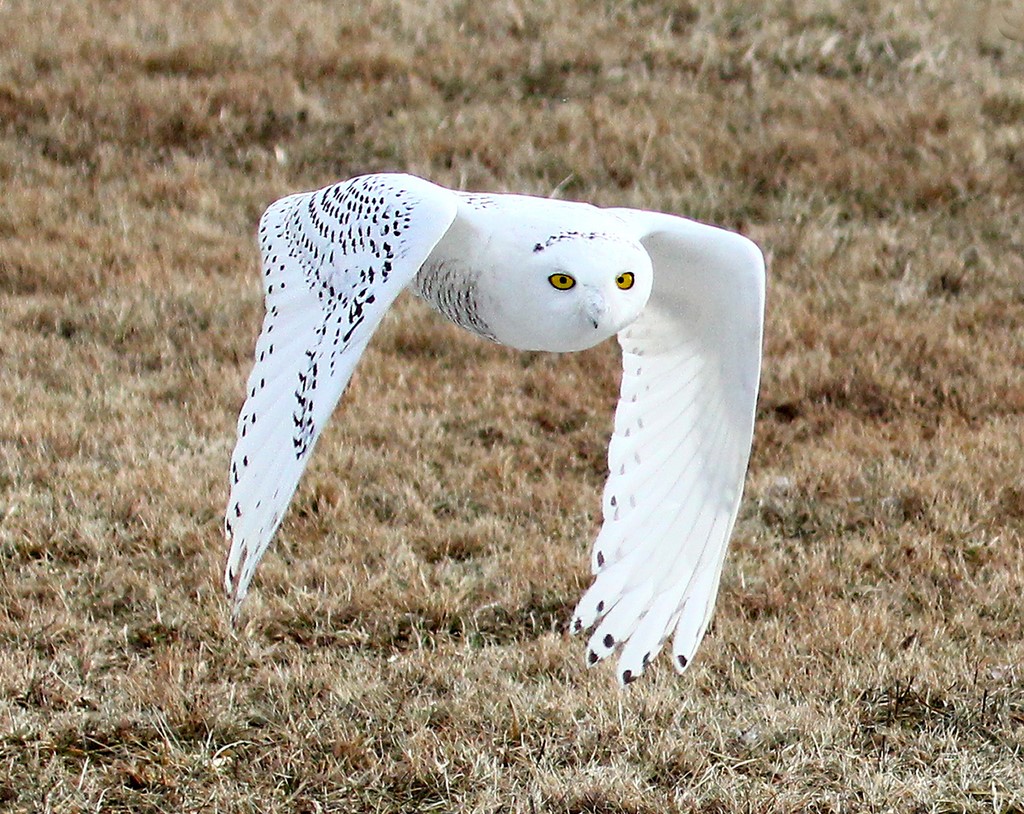Birdfinding.info ⇒ One of the most northerly breeding birds, and notoriously unpredictable due to its nomadic lifestyle. In summer it is fairly common in parts of northern Alaska (e.g., Barrow) and arctic Canada. In late fall and winter it occurs regularly across much of southern Canada, including the environs of Edmonton, Calgary, Winnipeg, Toronto, Ottawa, and Montreal. In the continental U.S. it occurs most regularly near the Canadian border from Montana to Michigan, and in coastal New England. Consistent sites include Sax-Zim Bog (Minnesota) and Plum Island (Massachusetts). In Eurasia it is much rarer and mostly confined to arctic tundra, but can also be found in winter on the steppes of Siberia (e.g., Novosibirsk) and Inner Mongolia (Hulunbuir).
Snowy Owl
Bubo scandiacus
Circumpolar: breeds on high arctic tundra; winters in both arctic and cold temperate regions.
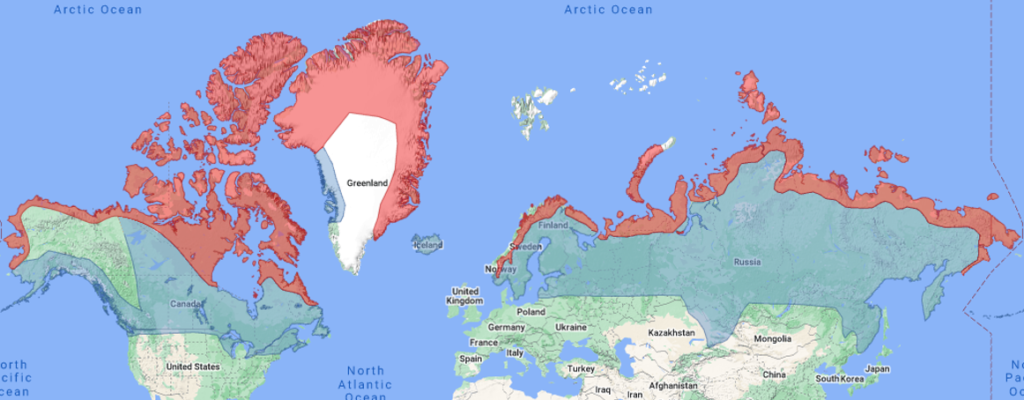
Approximate distribution of the Snowy Owl. © Xeno-Canto 2023
Breeding. Widespread in summer throughout the arctic region of North America: from the Seward Peninsula north and east across the barrens of northern Canada south to northeastern Manitoba, the Ungava Peninsula, and the northern tip of Labrador, and on all major islands of the Arctic Archipelago north to northern Ellesmere. Also in northern and eastern Greenland.
In Eurasia, its breeding distribution is comparatively limited: northernmost Norway, Finnmark, northern Finland, adjacent Karelia, and sparsely east across the Russian high arctic to the Chukchi Peninsula, including Novaya Zemlya, the New Siberian Islands, Wrangel Island. Also south along the western Bering Sea coast and on the Commander and outermost Aleutian Islands.
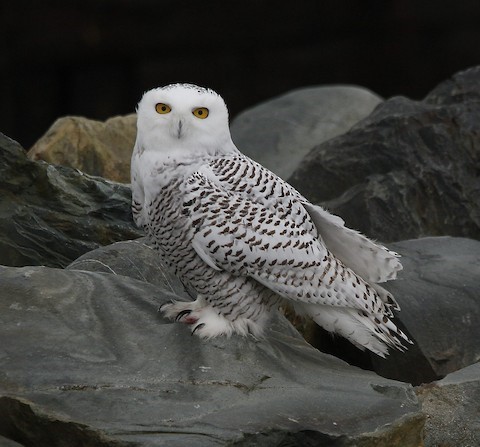
In winter many Snowy Owls frequent lakeshores and seacoasts. (Portugal Cove South, Newfoundland; November 19, 2021.) © Charles Fitzpatrick
Nomadic throughout its breeding range, apparently wandering in late spring, then settling to breed where lemming populations are high. On any given patch of high arctic tundra, it may be present one year and absent another. Sometimes nests outside of its usual range: e.g., Iceland, Svalbard, south-central Norway, and Shetland.
Nonbreeding. Winters in open habitats essentially throughout Alaska, mainland Canada, Newfoundland, and the northern contiguous U.S., but nomadic and unpredictable, occupying different areas from year to year. The main wintering grounds are the prairies, agricultural lands, lakeshores, and coasts of southern Canada and the northern tier of U.S. states, south to Montana, South Dakota, the Great Lakes, and Massachusetts. In some years, many wander much farther south into the Pacific Northwest, the central Great Plains, the Ohio Valley, or the Mid-Atlantic states—occasionally in numbers that amount to an irruption or invasion.
Eurasian populations winter mainly in remote areas, rarely wandering far south of the arctic. Somewhat regular in central and southern Finland, the steppes of southwestern Siberia, and the northern part of Inner Mongolia. Casual in winter south to western and central Europe.
Vagrants have been recorded south to South Korea, Oahu, southern California, central Texas, northern Florida, Bermuda, the Azores (Corvo, Flores, and Faial), and southern Spain.
Identification
Unique: a very large white owl that perches prominently in open terrain.

Snowy Owl, showing typical density of blackish spots, bars, and chevrons on the upperparts. (Etobicoke, Ontario; December 28, 2022.) © edithst-martin
The eyes are amber-yellow and the bill and talons are black. The head usually appears rounded, but two very small “ear-tufts” are sometimes visible.
The mostly white plumage is marked with variable amounts of black or dark-brown spots and bars, depending on age and sex.

Snowy Owl, showing typical thin brownish barring in a vest pattern on the underparts. (Linesville, Pennsylvania; January 21, 2021.) © Sandi Diehl
Most Snowy Owls show distinct blackish spots and chevrons on the upperparts, and brownish barring on the underparts—often giving a vested appearance.
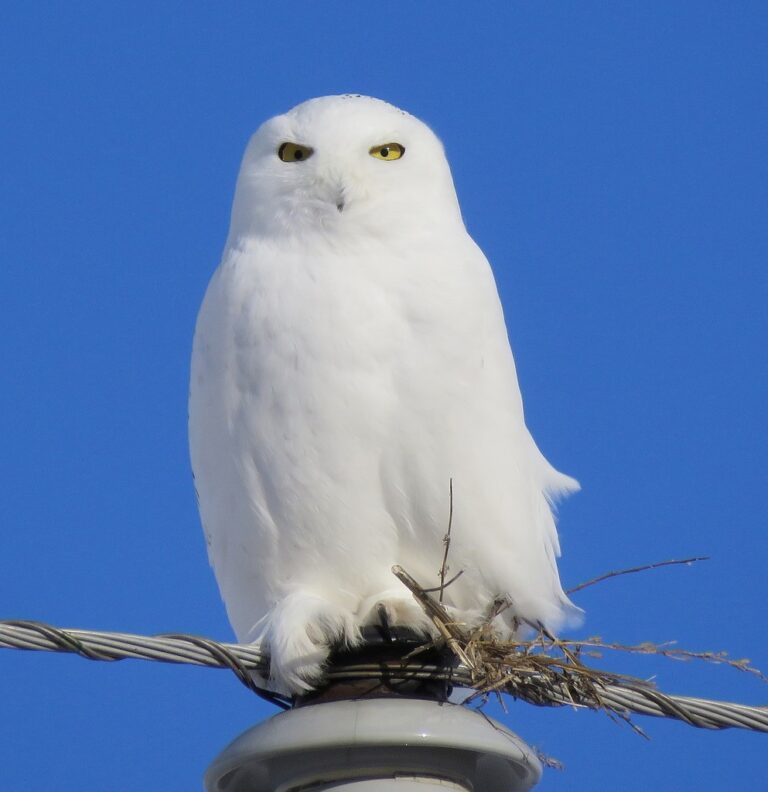
Snowy Owl, pure-white adult male. (Antler, North Dakota; December 15, 2018.) © bugger44
At the extremes, adult males can be all-white, whereas immature females can appear mostly black with a snow-white face.
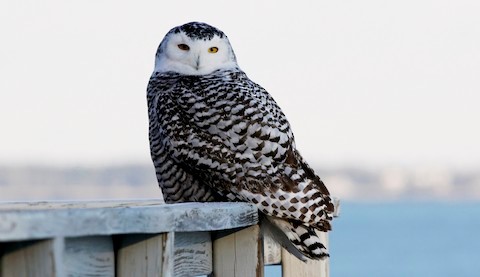
Snowy Owl, immature female showing maximal black in plumage. (Indian Head, Maine; December 16, 2017.) © Gary Jarvis
In flight, the underwings and undertail appear all- or nearly all-white on both sexes at all ages.

Snowy Owl, immature female in flight, showing mostly white underwing and undertail. (Rudyard, Michigan; December 22, 2021.) © Brad Imhoff
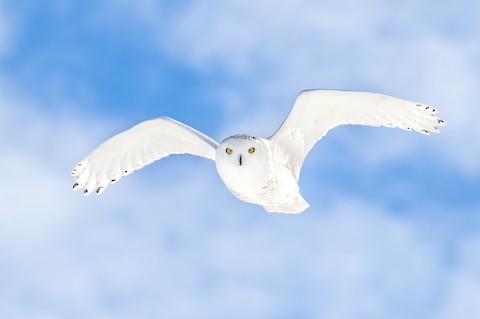
Snowy Owl, adult male in flight. (Beiseker, Alberta; December 4, 2022.) © Calvin S.
Notes
Monotypic species.
IUCN Red List Status: Vulnerable.
More Images of the Snowy Owl

Snowy Owl, pure-white adult male. (Wellesley, Ontario; February 14, 2021.) © David M. Gascoigne
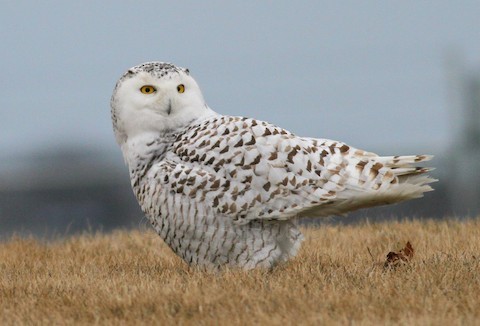
Snowy Owl, showing small “horns”—raised by wind or alertness. (Milwaukee, Wisconsin; January 4, 2020.) © Jim Edlhuber
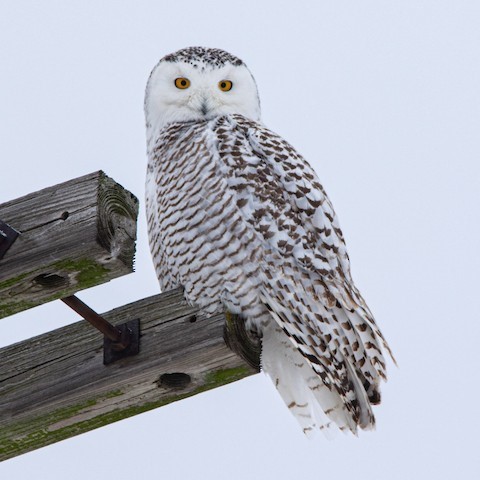
Snowy Owl, likely an immature female. (Robinson, Michigan; February 19, 2021.) © Craig Kingma
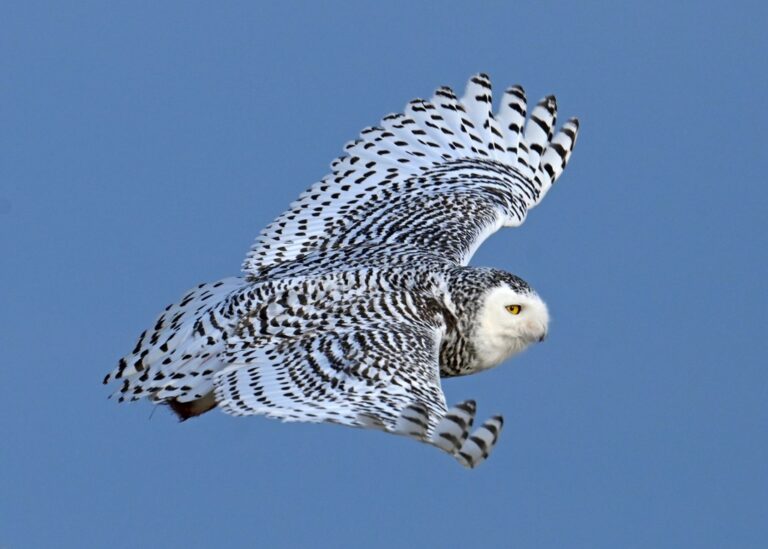
Snowy Owl, immature female in flight. (Duxbury, Massachusetts; December 10, 2021.) © Todd Prario
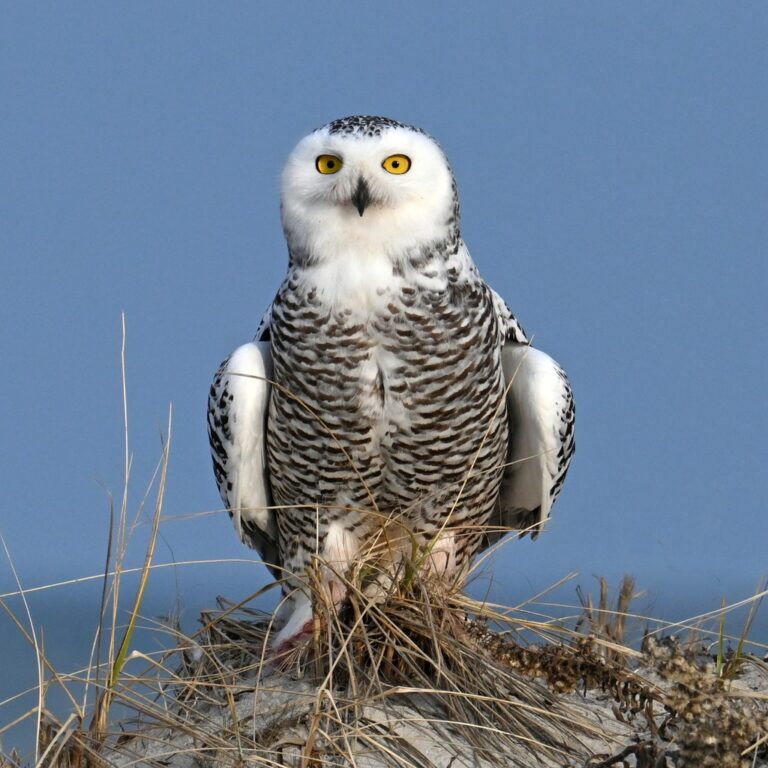
Snowy Owl. (Duxbury, Massachusetts; December 10, 2021.) © Todd Prario
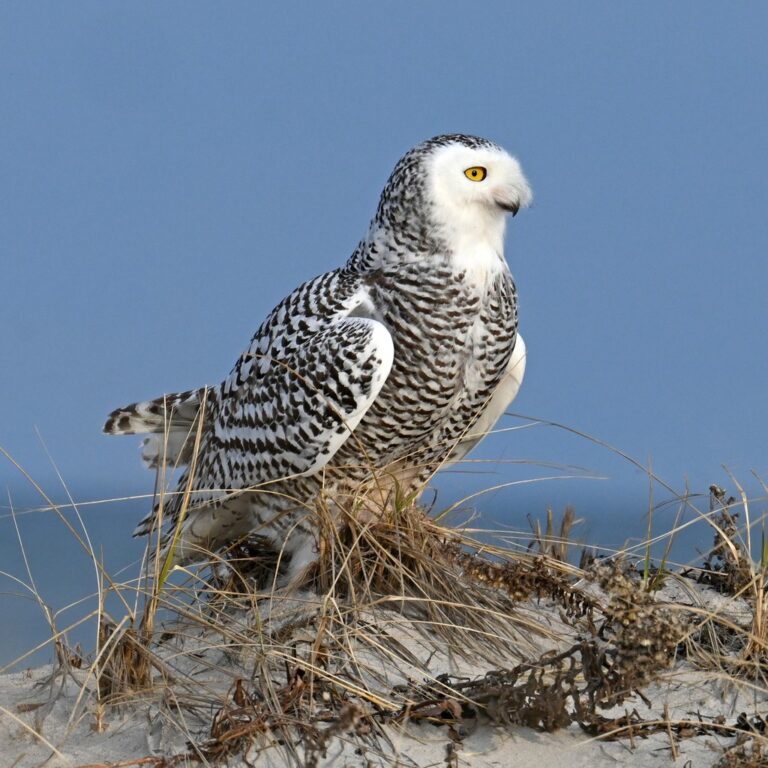
Snowy Owl, immature female. (Duxbury, Massachusetts; December 10, 2021.) © Todd Prario
References
Alderfer, J., and J.L. Dunn. 2021. National Geographic Complete Birds of North America (Third Edition). National Geographic Society, Washington, D.C.
BirdLife International. 2021. Bubo scandiacus. The IUCN Red List of Threatened Species 2021: e.T22689055A205475036. https://dx.doi.org/10.2305/IUCN.UK.2021-3.RLTS.T22689055A205475036.en. (Accessed January 5, 2023.)
Brazil, M. 2009. Birds of East Asia. Princeton University Press.
eBird. 2023. eBird: An online database of bird distribution and abundance. Cornell Lab of Ornithology, Ithaca, N.Y. http://www.ebird.org. (Accessed January 5, 2023.)
Garcia-del-Rey, E. 2011. Field Guide to the Birds of Macaronesia: Azores, Madeira, Canary Islands, Cape Verde. Lynx Editions, Barcelona.
iNaturalist. 2023. https://www.inaturalist.org/. (Accessed January 1, 2023.)
König, C., and F. Weick. 2008. Owls of the World (Second Edition). Yale University Press.
Mikkola, H. 2012. Owls of the World: A Photographic Guide. Firefly Books, London.
Mullarney, K., L. Svensson, D. Zetterström, and P.J. Grant. 1999. Birds of Europe. Princeton University Press.
Pyle, R.L., and P. Pyle. 2017. The Birds of the Hawaiian Islands: Occurrence, History, Distribution, and Status. Version 2 (January 1, 2017). http://hbs.bishopmuseum.org/birds/rlp-monograph/. B.P. Bishop Museum, Honolulu, Hawaii.
Salt, W.R., and J.R. Salt. 1976. The Birds of Alberta. Hurtig Publishers, Edmonton, Alberta.
Xeno-Canto. 2023. Snowy Owl – Bubo scandiacus. https://xeno-canto.org/species/Bubo-scandiacus. (Accessed January 5, 2023.)
